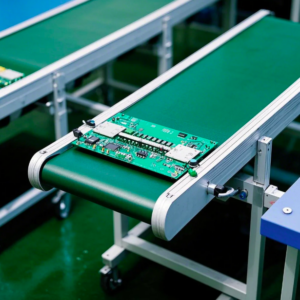An SMT line (Surface-Mount Technology line) is an essential part of modern electronics manufacturing. It is used to assemble surface-mount components onto printed circuit boards (PCBs) with high precision and speed. In this article, we will explore the function, working principle, and various applications of an SMT line, as well as how it operates in a typical production setting.

What is an SMT Line?
An SMT line is a complete assembly line used in the Surface-Mount Technology process, which involves mounting electronic components directly onto the surface of PCBs. This technology has replaced traditional through-hole assembly methods due to its higher efficiency, reduced component size, and ability to handle complex designs. The SMT line includes various machines, such as pick-and-place machines, soldering equipment, and inspection stations, all working together to ensure the precise assembly of electronic products.
Working Principle of an SMT Line
The SMT line works in a series of steps that automate the entire PCB assembly process. The first step involves placing the bare PCB on the line. Once the board is in position, the following key stages occur:
Solder Paste Printing: Solder paste is applied to the PCB using a stencil printer. This paste will later help solder the surface-mount components to the PCB.
Component Placement: The pick-and-place machines on the SMT line pick up tiny surface-mount components and place them precisely onto the PCB, aligning with the solder paste.
Reflow Soldering: After component placement, the PCB moves through a reflow oven where the solder paste melts, securely attaching the components to the board.
Inspection: Automated optical inspection (AOI) and X-ray inspection systems check the PCB for defects like misplaced components or soldering issues.
Final Testing: The completed PCB undergoes functional testing to ensure all components are working correctly before packaging.
Each step is automated and highly synchronized in the SMT line to ensure consistent quality and high throughput.
How Does an SMT Line Work in Practice?
In a typical SMT line, PCBs move through the system using conveyors, with each machine performing a specific task. The conveyor system keeps the process continuous, minimizing downtime and manual handling. Once a PCB is loaded onto the line, it travels through various workstations, starting with the application of solder paste and ending with final functional testing.
Throughout the process, the machines work autonomously, with minimal human intervention. This automation allows for faster production rates, more accurate placements, and reduced error rates. The SMT line also integrates advanced software that controls each machine’s movements, ensuring that the placement of components is always precise.
Applications of SMT Lines
SMT lines are used in a variety of industries where efficient and precise PCB assembly is crucial. Some of the most common applications include:
Consumer Electronics: Smartphones, tablets, laptops, and wearables all rely on SMT lines for efficient assembly.
Automotive Industry: Modern vehicles, including electric cars, use electronic systems assembled through SMT lines.
Telecommunications: The production of networking equipment, routers, and communication devices heavily depends on SMT lines for assembly.
Medical Devices: Many medical devices, such as diagnostic equipment and monitoring systems, are assembled using SMT lines for their high precision and reliability.
Conclusion
The SMT line is an indispensable tool in modern electronics manufacturing. Automating the process of assembling surface-mount components, it ensures faster production cycles, better precision, and higher-quality products. Whether in consumer electronics, automotive, telecommunications, or medical devices, SMT lines play a critical role in the development of advanced electronic systems. Their efficiency, versatility, and ability to handle complex designs make them a cornerstone of the electronics industry.
